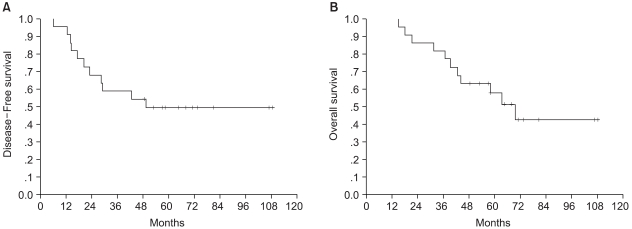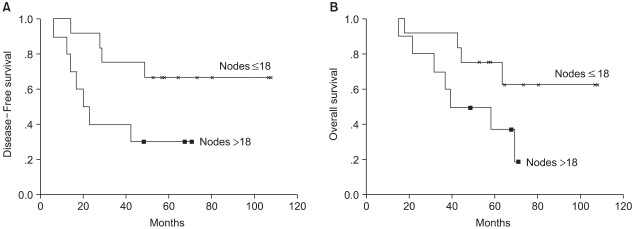Cancer Res Treat.
2005 Jun;37(3):137-142.
High-Dose Chemotherapy of Cyclophosphamide, Thiotepa and Carboplatin (CTCb) followed by Autologous Stem-Cell Transplantation as a Consolidation for Breast Cancer Patients with 10 or more Positive Lymph Nodes: a 5-Year follow-Up Results
- Affiliations
-
- 1Department of Internal Medicine, University of Ulsan College of Medicine, Asan Medical Center, Seoul, Korea. csuh@amc.seoul.kr
- 2Department of Internal Medicine, Gyeongsang National University Hospital, Jinju, Korea.
Abstract
- PURPOSE
The benefit of consolidation high-dose chemotherapy (HDC) for high-risk primary breast cancer is controversial. We evaluated the efficacy and safety of consolidation HDC with cyclophosphamide, thiotepa and carboplatin (CTCb) followed by autologous stem-cell transplantation (ASCT) in resected breast cancer patients with 10 or more positive lymph nodes. MATERIALS AND METHODS: Between December 1994 and April 2000, 22 patients were enrolled. All patients received 2 to 6 cycles of adjuvant chemotherapy after surgery for breast cancer. The HDC regimen consisted of cyclophosphamide 1, 500 mg/m2/day, thiotepa 125 mg/m2/day and carboplatin 200 mg/m2/day intravenous for 4 consecutive days. RESULTS: With a median follow-up of 58 months, 11 patients recurred and died. The median disease-free survival (DFS) and median overall survival (OS) were 49 and 69 months, respectively. The 5-year DFS and OS rates were 50% and 58%, respectively. The 12 patients with 10 to 18 involved nodes had better 5-year DFS (67%) and OS (75%) than 10 patients with more than 18 involved nodes (30% and 38%, respectively). The most common grade 3 or 4 nonhematologic toxicity was diarrhea, which occurred in 5 patients (23%). No treatment-related death was observed. CONCLUSION: Consolidation HDC with CTCb followed by ASCT for resected breast cancer with more than 10 positive nodes had an acceptable toxicity but does not show promising survival.
Keyword
MeSH Terms
Figure
Reference
-
1. Jones SE, Moon TE, Bonadonna G, Valagussa P, Rivkin S, Buzdar A, et al. Comparison of different trials of adjuvant chemotherapy in stage II breast cancer using a natural history data base. Am J Clin Oncol. 1987; 10:387–395. PMID: 3310603.
Article2. Buzdar AU, Kau SW, Hortobagyi GN, Ames FC, Holmes FA, Fraschini G, et al. Clinical course of patients with breast cancer with ten or more positive nodes who were treated with doxorubicin-containing adjuvant therapy. Cancer. 1992; 69:448–452. PMID: 1728373.
Article3. Davidson NE, Abeloff MD. Adjuvant systemic therapy in women with early-stage breast cancer at high risk for relapse. J Natl Cancer Inst. 1992; 84:301–305. PMID: 1531367.
Article4. Hryniuk W, Levine MN. Analysis of dose intensity for adjuvant chemotherapy trials in stage II breast cancer. J Clin Oncol. 1986; 4:1162–1170. PMID: 3525765.
Article5. Peters WP, Ross M, Vredenburgh JJ, Meisenberg B, Marks LB, Winer E, et al. High-dose chemotherapy and autologous bone marrow support as consolidation after standard-dose adjuvant therapy for high-risk primary breast cancer. J Clin Oncol. 1993; 11:1132–1143. PMID: 8501500.
Article6. Gianni AM, Siena S, Bregni M, Di Nicola M, Orefice S, Cusumano F, et al. Efficacy, toxicity, and applicability of high-dose sequential chemotherapy as adjuvant treatment in operable breast cancer with 10 or more involved axillary nodes: five-year results. J Clin Oncol. 1997; 15:2312–2321. PMID: 9196145.
Article7. Gradishar WJ, Tallman MS, Abrams JS. High-dose chemotherapy for breast cancer. Ann Intern Med. 1996; 125:599–604. PMID: 8815759.
Article8. Hortobagyi GN, Buzdar AU, Theriault RL, Valero V, Frye D, Booser DJ, et al. Randomized trial of high-dose chemotherapy and blood cell autografts for high-risk primary breast carcinoma. J Natl Cancer Inst. 2000; 92:225–233. PMID: 10655439.
Article9. Peters W, Rosner G, Vredenburgh J, Shpall EJ, Crump M, Marks L, et al. Updated results of a prospective, randomized comparison of two doses of combination alkylating agent (AA) as consolidation after CAF in high-risk primary breast cancer involving ten or more axillary lymph nodes (LN): CALGB 9082/SWOG 9114/NCIC MA-13. Proc Am Soc Clin Oncol. 2001; 20:67b. (abstr 2016).10. Tokuda Y, Tajima T, Narabayashi M, Takeyama K, Watanabe T, Fukutomi T, et al. Randomized phase III study of high- dose chemotherapy (HDC) with autologous stem cell support as consolidation in high-risk postoperative breast cancer: Japan Clinical Oncology Group (JCOG9208). Proc Am Soc Clin Oncol. 2001; 20:38a. (abstr 148).11. Rodenhuis S, Bontenbal M, Beex LV, Wagstaff J, Richel DJ, Nooij MA, et al. High-dose chemotherapy with hematopoietic stem-cell rescue for high-risk breast cancer. N Engl J Med. 2003; 349:7–16. PMID: 12840087.
Article12. Tallman MS, Gray R, Robert NJ, LeMaistre CF, Osborne CK, Vaughan WP, et al. Conventional adjuvant chemotherapy with or without high-dose chemotherapy and autologous stem-cell transplantation in high-risk breast cancer. N Engl J Med. 2003; 349:17–26. PMID: 12840088.
Article13. Zander AR, Kroger N, Schmoor C, Kruger W, Mobus V, Frickhofen N, et al. High-dose chemotherapy with autologous hematopoietic stem-cell support compared with standard-dose chemotherapy in breast cancer patients with 10 or more positive lymph nodes: first results of a randomized trial. J Clin Oncol. 2004; 22:2273–2283. PMID: 15111618.
Article14. Cho SH, Kim SW, Min YJ, Choi SJ, Kim JK, Kim TW, et al. High dose cyclophosphamide, thiotepa, and carboplatin followed by autologous peripheral stem cell rescue in patients with responsive metastatic or high-risk primary breast cancer. J Korean Cancer Assoc. 1998; 30:100–105.15. Bezwoda WR, Seymour L, Dansey RD. High-dose chemotherapy with hematopoietic rescue as primary treatment for metastatic breast cancer: a randomized trial. J Clin Oncol. 1995; 13:2483–2489. PMID: 7595697.
Article16. Bezwoda W. Randomised, controlled trial of high dose chemotherapy (HD-CNVP) versus standard dose (CAF) chemotherapy for high risk, surgically treated, primary breast cancer. Proc Am Soc Clin Oncol. 1999; 18:2a. (abstr 4).
Article17. Suh C, Kim HJ, Kim SH, Kim S, Lee SJ, Lee YS, et al. Low-dose lenograstim to enhance engraftment after autologous stem cell transplantation: a prospective randomized evaluation of two different fixed doses. Transfusion. 2004; 44:533–538. PMID: 15043569.
Article18. Damon LE, Wolf JL, Rugo HS, Gold E, Zander AR, Cassidy M, et al. High-dose chemotherapy (CTM) for breast cancer. Bone Marrow Transplant. 2000; 26:257–268. PMID: 10967563.
Article19. Zander A, Kruger W, Kroger N, Schmoor C, Mobus V, Frickhofen N, et al. High-dose chemotherapy with autologous hematopoietic stem-cell support (HSCS) vs. standard-dose chemotherapy in breast cancer patients with 10 or more positive lymph nodes: first results of a randomized trial. Proc Am Soc Clin Oncol. 2002; 21:415a. (abstr 1658).20. Nieto Y. The verdict is not in yet. Analysis of the randomized trials of high-dose chemotherapy for breast cancer. Haematologica. 2003; 88:201–211. PMID: 12604410.21. Stemmer SM, Hardan I, Raz H, Adamou AK, Inbar M, Gottfried M, et al. Adjuvant treatment of high-risk stage II breast cancer with doxorubicin followed by high-dose chemotherapy and autologous stem-cell transplantation: a single-institution experience with 132 consecutive patients. Bone Marrow Transplant. 2003; 31:655–661. PMID: 12692605.
Article22. Anderson LW, Chen TL, Colvin OM, Grochow LB, Collins JM, Kennedy MJ, et al. Cyclophosphamide and 4-Hydroxycyclophosphamide/ aldophosphamide kinetics in patients receiving high-dose cyclophosphamide chemotherapy. Clin Cancer Res. 1996; 2:1481–1487. PMID: 9816324.23. Huitema AD, Kerbusch T, Tibben MM, Rodenhuis S, Beijnen JH. Reduction of cyclophosphamide bioactivation by thiotepa: critical sequence-dependency in high-dose chemotherapy regimens. Cancer Chemother Pharmacol. 2000; 46:119–127. PMID: 10972481.
Article24. Fisher DC, Vredenburgh JJ, Petros WP, Hussein A, Berry DA, Elkordy M, et al. Reduced mortality following bone marrow transplantation for breast cancer with the addition of peripheral blood progenitor cells is due to a marked reduction in veno-occlusive disease of the liver. Bone Marrow Transplant. 1998; 21:117–122. PMID: 9489626.
Article
- Full Text Links
- Actions
-
Cited
- CITED
-
- Close
- Share
- Similar articles
-
- High-Dose Chemotherapy of Cyclophosphamide, Thiotepa, and Carboplatin (CTCb) Followed by Autologous Stem-Cell Transplantation for Metastatic Breast Cancer Patients: A 6-Year Follow-Up Result
- High-Dose Chemotherapy of Cyclophosphamide, Thiotepa, and Carboplatin (CTCb) with Autologous Peripheral Blood Stem Cell Transplantation for High-Risk Primary Breast Cancer and Metastatic Breast Cancer
- High Dose Chemotherapy with Ifosfamide, Carboplatin, and Etoposide Followed by Autologous Stem Cell Transplantation in Breast Cancer
- High Dose Cyclophosphamide, Thiotepa, and Carboplatin followed by Autologous Peripheral Stem Cell Rescue in Patients with Responsive Metastatic or High - Risk Primary Breast Cancer
- The Prognosis of breast Cancr with more than 10 Positive Nodes



